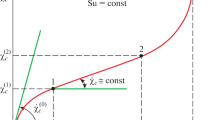Abstract
The behavior of the Hurst rescaled range during evolution of a system of elementary damages is investigated in simulation by the probabilistic cellular automation. It is established that the processes of the damage accumulation and the damage clustering evolution are the persistent random processes. The curves of the rescaled range statistics of the number of elementary damages have two marked linear segments, the second segment beginning at the times that are larger than 70% of the time of failure. It is possible to interpret this second segment appearance as a sign of the system transiting to the final stage of destruction.
Similar content being viewed by others
References
N. G. Tomilin, E. E. Damaskinskaya, and V. S. Kuksenko, “Generation of failure focus in heterogeneous materials (granite) under deformation,” Fiz. Tverd. Tela, 36, No. 10 (1994).
M. V. Kurlenya, A. G. Vostretsov, G. I. Kulakov, and G. E. Yakovitskaya, Recording and Processing of Electromagnetic Emission Signals in Rocks [in Russina], SO RAN, Novosibirsk (2000).
V. I. Vettegren’, V. S. Kuksenko, N. G. Tomilin, and M. A. Kryuchkov, “Microcrack statistics in heterogeneous materials (granite),” Fiz. Tverd. Tela, 46, No. 10 (2004).
E. Feder, Fractals, Plenum Press, New York (1988).
B. B. Mandelbrot, The Fractal Geometry of Nature, Freeman, San Francisco (1983).
D. V. Alekseev and P. V. Egorov, “Persistence of the crack accumulation process in loaded rocks and the concentration failure criterion,” Dokl. Akad. Nauk, 333, No. 6 (1993).
D. V. Alekseev, P. V. Egorov, V. V. Ivanov, et al., “Hurst statistics of the time dependence of electromagnetic emission with loading of rocks,” Fiz.-Tekh. Probl. Razrab. Polezn. Iskop., No. 5 (1993).
D. V. Alekseev and G. A. Kazunina, “Probabilistic cellular automation for modeling damage accumulation in loaded materials,” in: Proceedings of the International Conference on Geodynamics and Stress State of the Earth’s Bowels [in Russian], IGD SO RAN, Novosibirsk (2004).
D. V. Alekseev, Computerized Modeling of Physical Problems with Microsoft Visual Basic [in Russian], SOLON-Press, Moscow (2004).
D. V. Alekseev and G. A. Kazunina, “Kinetics of clusters of elementary damages in loaded materials: Probabilistic cellular automation modeling,” Fiz.-Tekh. Probl. Razrab. Polezn. Iskop., No. 1 (2006).
Author information
Authors and Affiliations
Additional information
__________
Translated from Fiziko-Tekhnicheskie Problemy Razrabotki Poleznykh Iskopaemykh, No. 4, pp. 69–74, July–August, 2006.
Rights and permissions
About this article
Cite this article
Alekseev, D.V., Kazunina, G.A. Simulation analysis of the kinetics of damage accumulation process in loaded materials with the hurst rescaled range. J Min Sci 42, 369–373 (2006). https://doi.org/10.1007/s10913-006-0065-0
Received:
Issue Date:
DOI: https://doi.org/10.1007/s10913-006-0065-0




